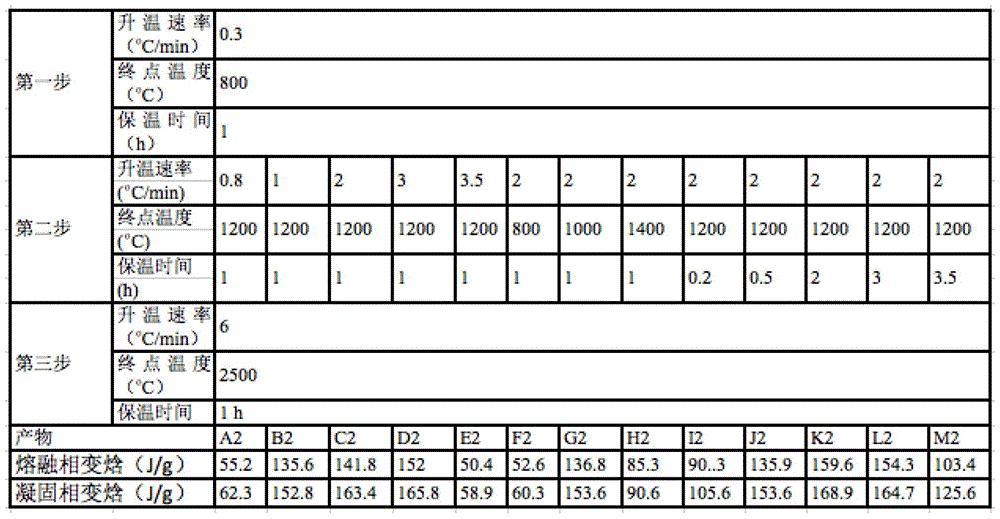Graphene-based composite phase-change membrane and preparation method thereof
A compound phase change and graphene technology, applied in chemical instruments and methods, heat exchange materials, sustainable manufacturing/processing, etc.
- Summary
- Abstract
- Description
- Claims
- Application Information
AI Technical Summary
Problems solved by technology
Method used
Image
Examples
Embodiment 1
[0023] (1) Extrude the graphene oxide aqueous solution with a concentration of 10mg / mL from a preparation device with a straight die at a continuous speed of 10m / min and then enter the coagulation solution (methanol, the temperature is 40°C), stay for 20 seconds, and solidify To form a graphene oxide gel film, the graphene oxide gel film was placed in a refrigerator at -18°C and in liquid nitrogen for sufficient freezing.
[0024] (2) Heating the frozen graphene oxide gel film to 800°C at a rate of 1°C / min in an inert gas atmosphere, and keeping it warm for 0.5h;
[0025] (3) Raise the temperature to 1300°C at a rate of 3°C / min in an inert gas atmosphere and keep it warm for 0.5h;
[0026] (4) Raise the temperature to 3000°C at a rate of 8°C / min in an inert gas atmosphere and keep it warm for 0.5h to obtain a graphene airgel film
[0027] Observation by scanning electron microscope found that the graphene airgel membrane (A) obtained after being fully frozen in a refrigerator...
Embodiment 2
[0032] (1) Extrude the graphene oxide aqueous solution with a concentration of 60mg / mL from the preparation device with a straight die at a continuous speed of 10m / min and then enter the coagulation solution (methanol, the temperature is 40°C), stay for 20 seconds, and solidify To form a graphene oxide gel film, the graphene oxide gel film was placed in liquid nitrogen and frozen for 3min, 5min, 15min, 30min, and 35min. The graphene oxide gel film (a, b, c, d, e) after freezing treatment was observed under the scanning electron microscope, the graphene oxide gel film a had more stacks and less holes; the graphene oxide gel film Membranes b, c, and d have uniform pores, and the degree of density increases in turn, and the structure of graphene oxide gel membrane e is damaged.
[0033] (2) Heating the frozen graphene oxide gel film to 800°C at a rate of 1°C / min in an inert gas atmosphere, and keeping it warm for 0.5h;
[0034] (3) Raise the temperature to 1300°C at a rate of 3°...
Embodiment 3
[0038] (1) Extrude the graphene oxide aqueous solution with a concentration of 1mg / mL from a preparation device with a straight die at a continuous speed of 10m / min and enter the coagulation solution (cyclohexanone, temperature 30°C) for 10 seconds , solidify into a graphene oxide gel film, and place the graphene oxide gel film in liquid nitrogen for 25 minutes.
[0039] (2) Heating the frozen graphene oxide gel film to 800°C at a rate of 1°C / min in an inert gas atmosphere, and keeping it warm for 0.5h;
[0040] (3) Raise the temperature to 1300°C at a rate of 3°C / min in an inert gas atmosphere and keep it warm for 0.5h;
[0041] (4) In an inert gas atmosphere, the temperature was raised to 3000°C at a rate of 8°C / min, and kept for 0.5h to obtain a graphene airgel film;
[0042] (5) Soak the airgel film obtained in step 4 in a dichloromethane solution of paraffin wax with a concentration of 10g / ml for 5h, and then dry it in a vacuum oven at 30°C to obtain a composite phase ch...
PUM
 Login to View More
Login to View More Abstract
Description
Claims
Application Information
 Login to View More
Login to View More - R&D
- Intellectual Property
- Life Sciences
- Materials
- Tech Scout
- Unparalleled Data Quality
- Higher Quality Content
- 60% Fewer Hallucinations
Browse by: Latest US Patents, China's latest patents, Technical Efficacy Thesaurus, Application Domain, Technology Topic, Popular Technical Reports.
© 2025 PatSnap. All rights reserved.Legal|Privacy policy|Modern Slavery Act Transparency Statement|Sitemap|About US| Contact US: help@patsnap.com



